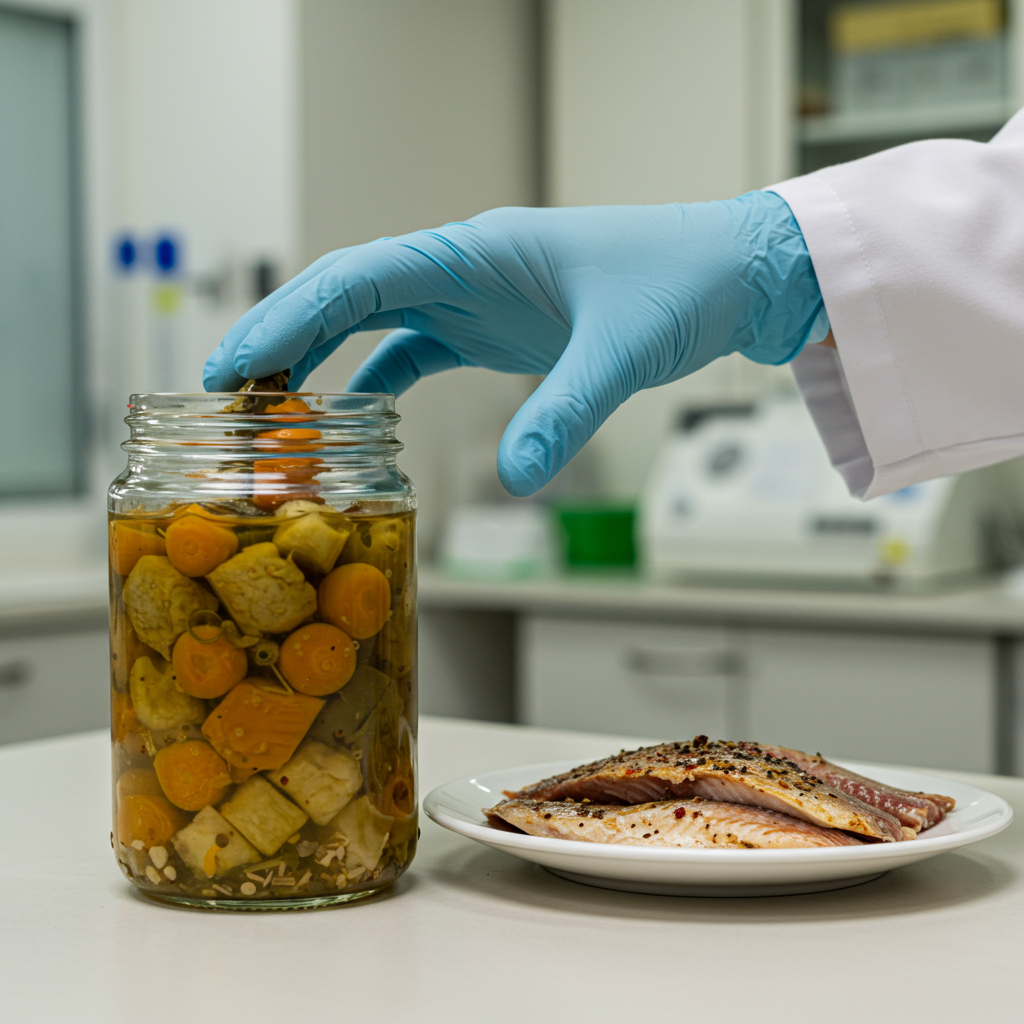An urgent public health warning has been issued following a severe outbreak of foodborne botulism in California. Eight people were hospitalized after consuming a homemade salad contaminated with Clostridium botulinum, a potent and potentially fatal neurotoxin. The incident occurred at a family gathering in Fresno County, highlighting the critical dangers of improper food preparation and preservation methods, even within seemingly safe home environments.
The outbreak stemmed from two events held on June 21 and June 22, 2024, attended by approximately 31 individuals. The suspected culprit was a salad containing uncooked nopales, the pads of the prickly pear cactus. While nopales are a popular and healthy ingredient, how they were prepared and stored in this instance proved tragically dangerous.
Rapid Onset of Severe symptoms
Attendees began experiencing alarming symptoms mere hours after eating the salad. A 42-year-old woman reported feeling dizzy, experiencing blurry vision, a drooping eyelid, sore throat, gastrointestinal distress, and difficulty swallowing. Though initially dismissed, these symptoms are classic indicators of botulism poisoning.
Botulism is a rare but extremely serious illness. It attacks the body’s nerves, leading to muscle paralysis, breathing difficulties, and, if untreated, can be fatal. By June 27, just days after the events, ten individuals who had eaten the salad sought emergency medical care at two local hospitals in Fresno County. The rapid progression and similarity of their symptoms immediately raised concerns among medical professionals about a potential widespread poisoning.
The Investigation Uncovers the Source
Responding swiftly, the CDC, the Fresno County Department of Public Health, and the California Department of Public Health launched a joint investigation. Their efforts focused on identifying the source of the mysterious illness affecting multiple attendees. Through careful interviews and laboratory testing, the trail led back to the nopales salad.
Further analysis revealed the dangerous conditions surrounding the salad’s key ingredient. The uncooked nopales had been left unrefrigerated in sweltering 100-degree Fahrenheit heat during the events. Crucially, the investigation pinpointed the preparation method of the home-preserved nopales used in the salad as the primary vector for the deadly toxin.
Dangerous Home Preservation Practices
Officials discovered that one of the diagnosed patients had prepared the nopales used in the salad. This individual had home-preserved the uncooked cactus pads using reused commercial glass jars. The process involved immersing empty jars in boiling water, adding chopped, uncooked nopales mixed with a small amount of salt, sealing the jars with new metal lids, and storing them for six weeks in an outdoor shed.
While this method might have been practiced for years without incident, it inadvertently created ideal conditions for Clostridium botulinum spores to flourish and produce their toxin. These spores are commonly found in soil and on the surface of fruits and vegetables. They thrive in low-oxygen, low-acid environments with moderate to high moisture and temperatures between 38°F and 113°F – precisely the conditions created by storing improperly processed nopales in a sealed jar in a hot outdoor shed. The lack of proper pressure canning, high temperatures, or sufficient acidity failed to kill the heat-resistant spores.
The Toll of Botulism Poisoning
Ultimately, eight of the ten individuals who sought treatment were confirmed to have clinical botulism. This incident stands as one of the largest documented foodborne botulism outbreaks in California history. The symptoms reported by the eight diagnosed patients were severe and consistent with neurotoxin exposure: all eight experienced double vision, seven had a hoarse voice, and six reported dizziness and difficulty swallowing. The woman who first experienced severe symptoms and had eaten the salad at both events was among those most affected.
The severity of the poisoning necessitated prolonged hospitalization for all eight patients, ranging from two days to a staggering 42 days. Six required admission to an intensive care unit (ICU), and two needed invasive mechanical ventilation to assist their breathing. Thankfully, the CDC’s case report confirmed that all eight patients diagnosed in this outbreak survived and ultimately recovered, though recovery from severe botulism can be a lengthy process often requiring extensive rehabilitation.
Understanding the Risks of Botulism
Botulism is a rare but life-threatening illness caused by toxins produced by Clostridium botulinum bacteria. It typically results from consuming contaminated food or, less commonly, from wound contamination. The toxin disrupts nerve function, leading to muscle weakness and paralysis. In cases of foodborne botulism, symptoms generally begin 12 to 36 hours after ingesting the contaminated food, depending on the amount of toxin consumed.
While rare in the United States, with the CDC estimating about 25 cases of foodborne botulism annually, its potential consequences are severe. If left untreated, the paralysis can affect the muscles needed for breathing, leading to death. Approximately five percent of individuals who contract botulism die, even with treatment. For survivors, significant physical therapy may be necessary to relearn basic functions like walking and talking due to lasting muscle weakness and paralysis.
Broader Context: The Importance of Food Safety
This botulism outbreak serves as a stark reminder of the critical importance of food safety practices in preventing serious illness. While botulism is relatively uncommon compared to other foodborne pathogens, outbreaks of various contaminants pose ongoing risks. For instance, recent large-scale incidents like the Listeria outbreak linked to deli meats, which tragically resulted in multiple fatalities and dozens of hospitalizations across several states, underscore the need for vigilance from both food producers and consumers. Listeria monocytogenes is another bacterium that can survive and grow at refrigerated temperatures, posing a particular threat to vulnerable populations. Understanding and adhering to proper food handling, storage, and preparation guidelines are essential steps anyone can take to protect themselves and their families from potentially devastating foodborne illnesses.
Preventing Botulism at Home
The Fresno County health department strongly advises the public to follow validated guidelines for food preservation and preparation to minimize the risk of botulism. Home canning, in particular, poses risks if not performed correctly.
To effectively kill Clostridium botulinum spores, low-acid foods (which include most vegetables like nopales, meats, and seafood) must be processed using a pressure canner at temperatures between 240°F and 250°F. Boiling water bath canning is not sufficient for low-acid foods and should only be used for high-acid foods like fruits, pickles, and jams with added acid. Using untested recipes, reusing jars or lids improperly, inadequate heating, or improper storage temperatures can all create environments where deadly toxins can form. Always follow tested recipes from reliable sources like the USDA or Extension offices and ensure proper sterilization and storage techniques are strictly followed.
Frequently Asked Questions
What caused the botulism outbreak at the California family gathering?
The outbreak was caused by Clostridium botulinum toxin present in a homemade salad made with uncooked nopales (prickly pear cactus pads). The nopales were home-preserved in reused glass jars with insufficient processing (only boiling water bath, not pressure canning) and low salt, then stored in an outdoor shed in high temperatures. This created a low-oxygen, low-acid environment with favorable temperatures for the C. botulinum spores, which are common on produce, to grow and produce the deadly neurotoxin.
What are the symptoms of foodborne botulism and when do they appear?
Symptoms of foodborne botulism typically begin 12 to 36 hours after consuming the contaminated food, although onset can vary. Common symptoms reported in this outbreak and generally include difficulty swallowing, muscle weakness, double vision, blurry vision, drooping eyelids, slurred speech, hoarse voice, difficulty breathing, and trouble moving the eyes. These symptoms are caused by the neurotoxin attacking the body’s nerves and can lead to paralysis.
How can home cooks prevent botulism when canning or preserving food?
Preventing botulism in home-preserved foods requires strictly following tested, science-based guidelines. Low-acid foods (like most vegetables, meats, and seafood, including nopales) must be processed using a pressure canner at temperatures of 240°F-250°F for the specified time to kill Clostridium botulinum spores. Boiling water bath canning is not sufficient for low-acid foods. Always use proper canning equipment, follow validated recipes from reputable sources (like USDA), use new lids, and ensure jars are properly sealed and stored at recommended temperatures. Avoid using untested or traditional methods that do not account for modern scientific understanding of spore elimination.
This incident underscores the hidden dangers that can exist in homemade foods if safe preparation and preservation techniques are not strictly followed. Public health officials continue to monitor the situation and urge everyone to prioritize food safety to prevent future outbreaks.
Word Count Check: Estimated word count: 1015




